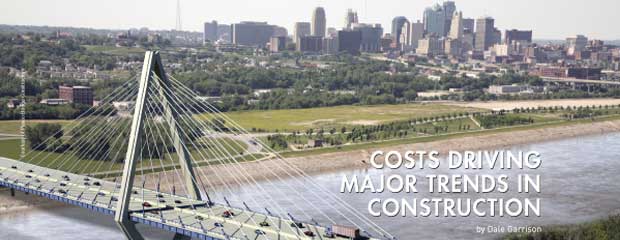Despite economic pressures from the nation’s economy and shortages of material and labor, there’s still a growing demand—and plenty of work for construction companies
The nation’s aging infrastructure and other pressures mean that many techniques will change, but work, in most cases, will proceed. “Our roads, bridges, even the electrical network are all at a mature age and need attention,” daid Kim Mastalio, president of the Strategic Sales & Marketing Division for Black & Veatch. “There’s a tremendous amount of work that needs to be done.”
Cost will affect, but not deter, project. Even as more structures need repair or replacement, building standards and material shortages are pushing prices.
“The green building trend means we have to be more efficient in how we build everything,” Mastalio said. “That means not only more efficient operation, but less waste during construction. Of course, there is a premium to be paid for that. Society always wants to do things to help the environment, but the costs will be expensive.”
Sustainable construction methods are especially challenging, noted Greg Graves, president and CEO of Burns and McDonnell. “Sustainability within construction can be very challenging. We’ve designed a number of projects for long-term sustainability, but how do you build it in the first place with those same concepts in mind?” The cascade of issues is almost endless, from reusing fill to rearranging schedules.
TIME IS MONEY
Tighter schedules are likely for other reasons as well. “To combat rising costs, everyone is looking at tight timelines,” said Don Curtis, Kansas City manager for HDR. “If you shorten the time a project is in planning and construction, you limit your
exposure to rising prices. There’s a lot of pressure for that.”
One of the most popular responses has been the design-build technique, where the designer and builder function as a single team. “You realize two primary savings by doing that,” Curtis said. “But the biggest one is time. You can telescope the schedule because the designer and builder are working hand in glove. You don’t have to wait for sequential steps.”
Scott Smith, CEO of HNTB Corporation, HNTB’s engineering division, said design-build is utilized in a growing host of areas. “It’s been fairly common in vertical (building) construction, but it’s now more common on major civil projects all across the country.” The process is being used on replacement of Kansas City’s Paseo Bridge, as well as a similar span for I-64 in St. Louis.
Even where design-build is not formally required, closer ties between different disciplines is increasing—even though engineers and architects have not always been on friendly terms.“We have to collaborate on these important projects,”
said Roger Dick, Burns and McDonnell marketingand communications manager. “It’s notalways easy, but it’s becoming almost requiredin every project.”
